GEOLOGY QUIZ 1 - RESERVOIR ROCKS
1/146
Earn XP
Description and Tags
Porosity+Permeability
Name | Mastery | Learn | Test | Matching | Spaced |
|---|
No study sessions yet.
147 Terms
Sedimentary rocks are made up of __________ sediments.
Consolidated (ie. firm and conherent)
Sediments can be classified in these 3 ways
Solid particles of pre-existing rocks (from weathering)
Mineral crystals (settled from solutions that contain material dissolved during chemical weathering)
Minerals extracted by organisms to build their shells
Name the 3 types of sedimentary rocks
Siliciclastic (detrital)
Chemical
Biochemical (organic)
What are the 3 main cementing agents in sedimentary rocks?
Quartz (sandstone)
Hematite (sandstone)
Calcite (limestone)
What is the best type of reservoir rock?
Chemical limestone
How does chemical limestone transform from an initial state of near zero porosity into a highly porous reservoir rock?
The brittle (fragile) nature of chemical limestone combines with:
vast amounts of time
tectonic forces
the dissolution of cement by passing ground water
to result in a highly porous, ideal reservoir rock.
Name the 2 types of shale
Silty
Clayey
Which type of shale (silty or clayey) forms a better reservoir rock, and why?
Silty shale is a better reservoir rock than clayey shale, as the fractures in silty shale will tend to stay open because of the larger grain size.
Shale/siltstone are highly abundant (~75%) when compared to other types of sedimentary rocks. Why?
Shale/Siltstone form in marine environments, which have covered vasts amount of the globe for millions of years. (ie. their depositional environment is far more widespread than that of other sedimentary rocks)
Shale forms in environments where very fine particles can settle out, such as deep oceans, lakes, and other low-energy settings. These environments are extensive and can cover vast areas for millions of years, allowing for the accumulation of thick shale deposits.
Siltstone forms in somewhat higher energy environments compared to shale, like deltaic settings, nearshore marine areas, or riverbeds. These environments are more restricted in size compared to deep marine or offshore basins where shale tends to accumulate.
Broken or eroded pieces of rocks and minerals deposited by water, wind, ice, or some other physical process
Clastic sediments
These are produced by inorganic (nonbiological) precipitation of dissolved compounds (e.g., through evaporation)
Chemical sediments
This type of sediment is produced by organic (biological) precipitation of the remains of living organisms
Biogenic sediment
What is the 3 step formation process of sedimentary rocks?
Weathering and erosion
Transportation and deposition
Lithification (compaction and cementation)
How are detrital/siliciclastic rocks classified?
According to their grain size.
Name 4 features of siliciclastic rocks that can help reveal the reservoir characteristics of the siliciclastic formation
Composition
Texture (size/shape/sorting)
Depositional environment
Post-depositional processes (ie. cementation)
What are the 4 fundamental components of sedimentary rocks?
Grains (sand grains, fossils, ooids, etc.)
Pores (space with no minerals - typically filled with water)
Matrix (fine-grained clay-sized sediment)
Cement (chemically precipitated mineral material)
Refers to rocks capable of splitting along closely spaced planes
Fissile
A type of sandstone containing >25% feldspars
Arkose
A sedimentary rock made up of gravel-sized angular clasts
Breccia
A sedimentary rock made up of gravel-sized rounded clasts
Conglomerate
A fine-grained sedimentary rock composed of clay-sized particles and silt-sized particles
Mudstone
Name the 4 grain size categories of sedimentary rocks and define their boundaries in mm

What type of sedimentary rock is coal?
Biochemical
Name the 2 major types if carbonate rocks
Limestone (mainly composed of calcite)
Dolomite/Dolostone (mainly composed of dolomite - a result of the chemical alteration [dolomitization] of limestone)
What type of rocks form from the accumulation of biological material such as the shells and skeletons of marine organisms -which extract calcium carbonate from seawater to build their shells - and accumulate on the seafloor when they die and become compacted into rock over time?
Carbonate rocks (limestone, dolomite)
This type of porosity develops during the deposition of soft sediments
Primary porosity
What is diagenesis?
Physical, chemical, and biological changes that occur in sediments after they are deposited, but before they are lithified into sedimentary rock.
What are the 2 types of primary pores?
Intergranular pores of clasts (siliciclastic rocks)
Intercrystaline and fenestral (carbonate rocks)
Which type of porosity is typically more uniform: primary or secondary porosity?
Primary
This type of porosity is developed by geologic processes after diagenesis (ie. after the formation of the rock)
Secondary porosity
Void spaces or cavities found within carbonate rocks, typically formed through dissolution or chemical weathering
Vugs
Give 3 examples of secondary porosity
Grain dissolution in sandstone or carbonates
Vugs and solution cavities in carbonates
Fractures in some sandstones, shales, and carbonates
For each of the following descriptions, name the porosity type and indicate whether it is considered primary or secondary porosity:
Interstitial void space between framework grains
Breakage due to Earth stresses
Small pores mainly between detrital framework grains or cement
Partial or complete dissolution of authigenic grains (or within the grains)
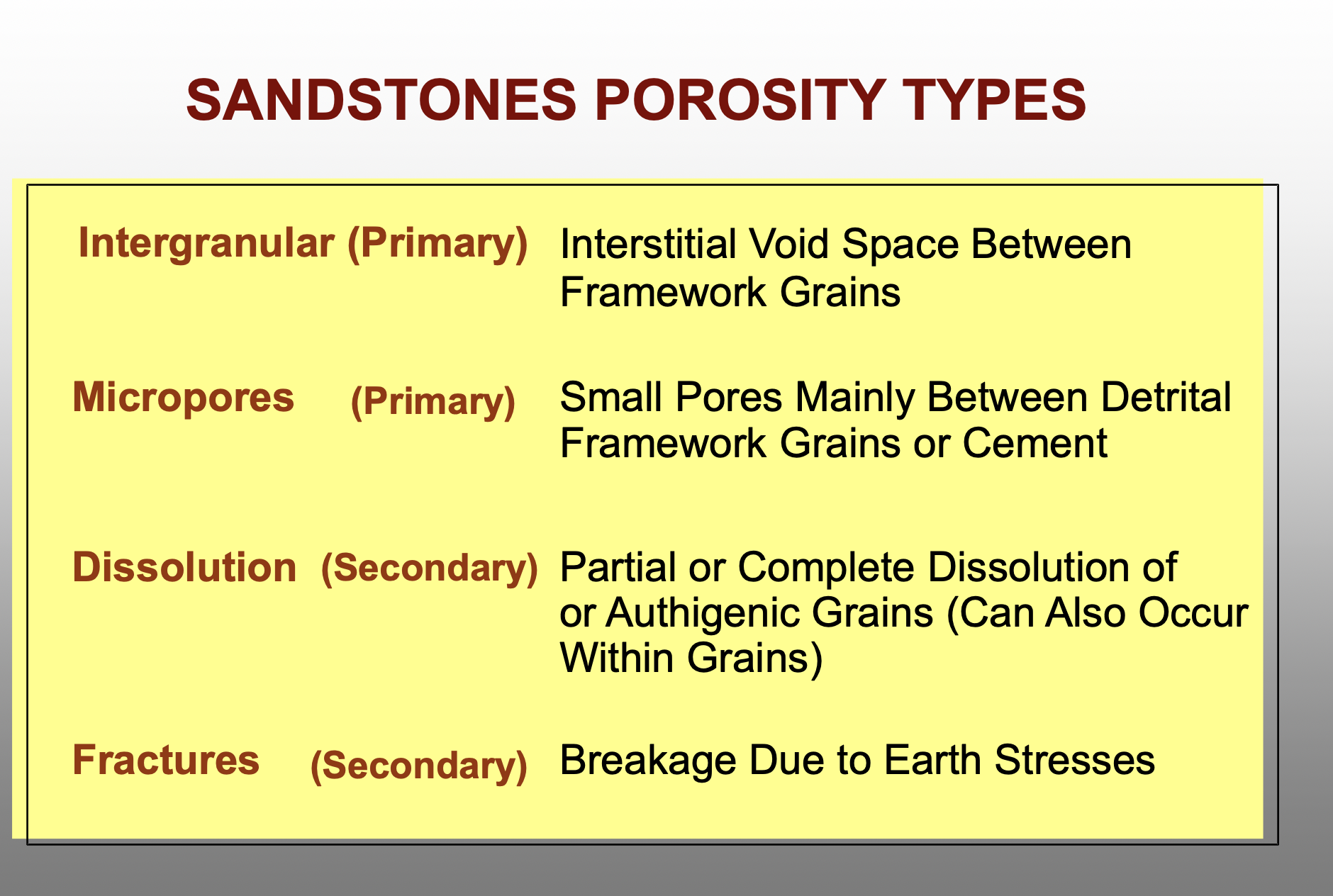
Name 4 textural parameters that affect primary porosity
Particle shape (roundness & sphericity)
Packing and grain orientation
Sorting
Particle size
Relate porosity to roundness and sphericity
ie:
as roundness increases, does porosity increase or decrease?
as sphericity increases, does porosity increase or decrease?
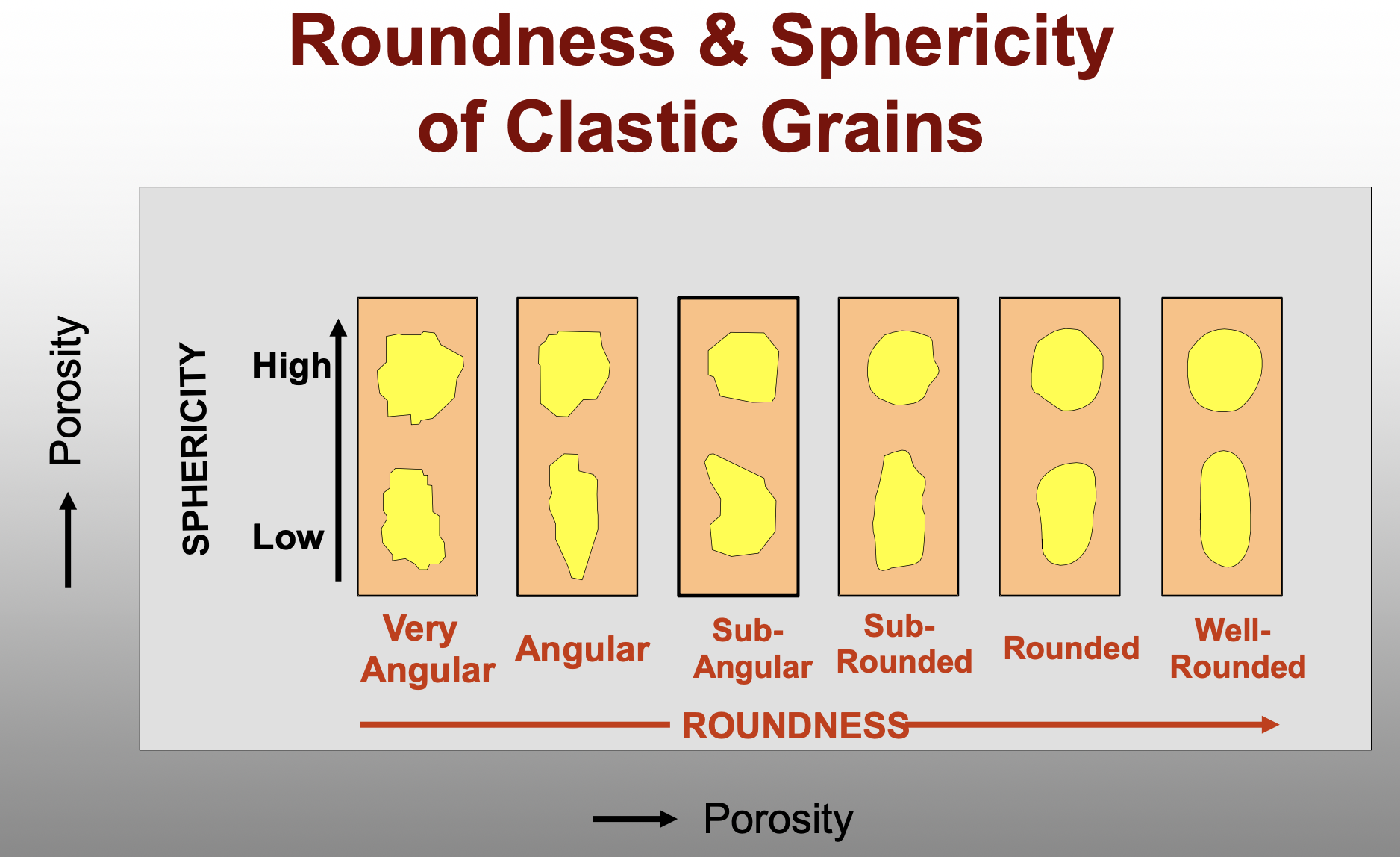
What is the formula for porosity?
Φ = PV/BV or
Φ = BV-MV/BV
Relate sorting to porosity
ie:
does porosity increase or decrease with improved sorting?
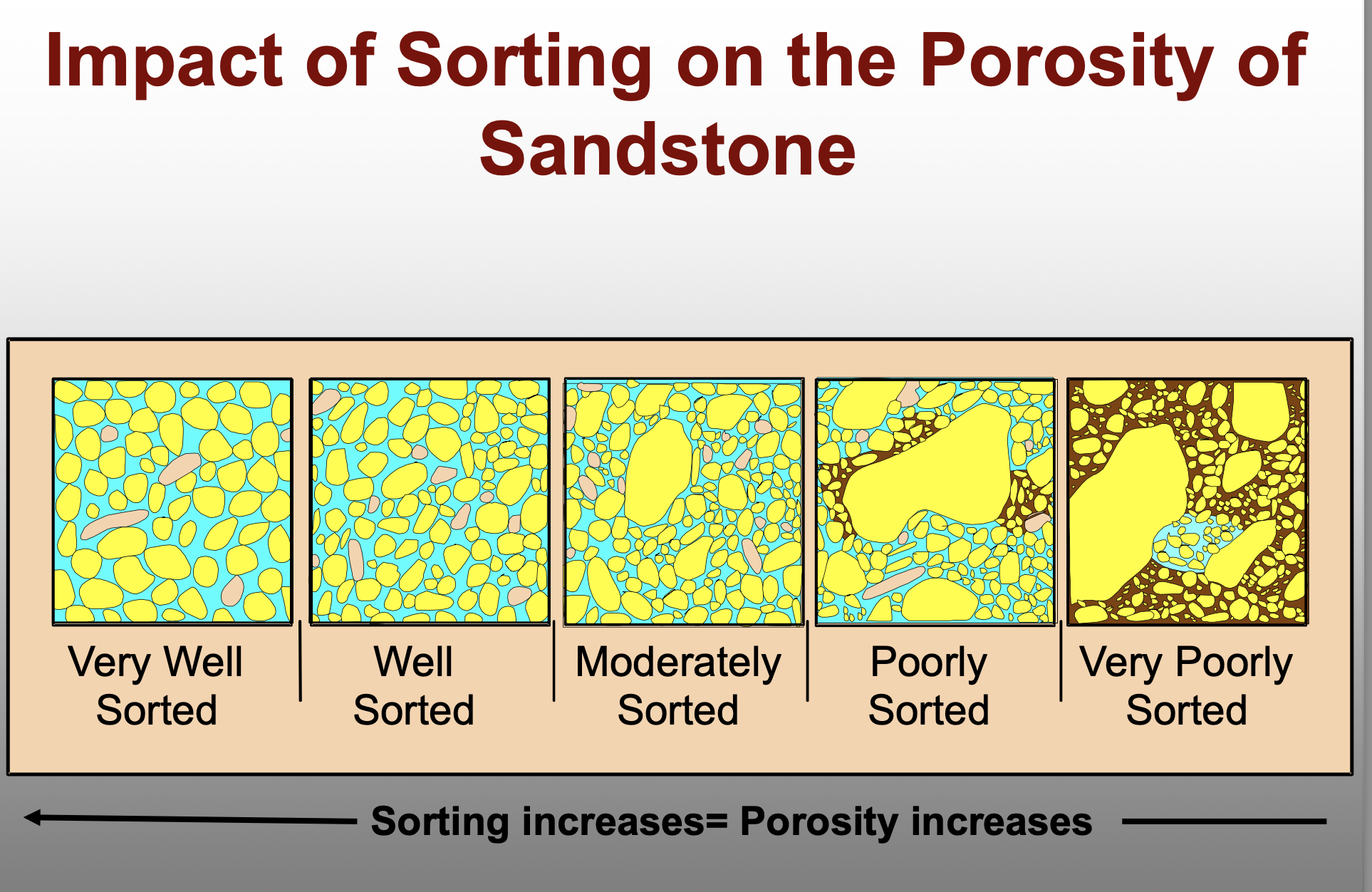
What are the 2 most common lithologies of conventional reservoirs?
Sandstone and limestone
What are the most common lithologies of unconventional reservoirs?
Shale and tight sandstone/siltstone
Name 4 types of unconventional reservoirs
Oilsands
Shale gas/oil
Coal-bed methane
Gas hydrate
This feature of rock pores restricts the flow through the pores
Pore throats
These types of pores form due to the dissolution and collapse of ooids (ie. leached fossils)
Moldic pores
Tend to be isolated (ie. low effective porosity/low perm)
TorF: Modic, vugular and cavernous pores form during sedimentation
False.
These pores all form due to dissolution, after sedimentation occurs. (diagenic)
TorF: Porosity in sandstone is typically lower than that of idealized packed spheres
True.
This is due to:
variation in grain size/shape (ie. sorting/sphericity/rounding)
cementation and compaction
TorF: As the burial depth increases the pore water pressure decreases
Wallahi this is false
Pore pressure increases with increasing depth
This is responsible for the gradual migration of liquids in reservoir rocks with good permeability where the pores are connected
Differential hydrostatic pressure
Define Primary Migration
The movement of hydrocarbons from source rock into reservoir rock
Define Secondary Migration
The movement of hydrocarbons within a reservoir rock
What is the unit of measurement of the permeability of a rock?
the Darcy
What is the single most important property of a reservoir rock?
Permeability
TorF: Clays increase both the porosity and permeability of a reservoir
False - they decrease both.
Name some common clay minerals
Kaolinite
Smectite
Chlorite
Illite
What types of rocks make up more than half of the sedimentary record?
Shales
What is meant by the term ‘Authigenic’?
Authigenic means ‘“formed in place”
Do reefs form carbonate or siliciclastic reservoir rocks?
Carbonate
Is a dune sandstone a carbonate or siliciclastic rock?
Siliciclastic
A type of sandstone with >20% of older rock fragments
Greywacke
As reservoir rocks, which typically have higher production volumes: sandstones or carbonates?
Carbonates
The process of sand grains being picked up by the wind and carried a short distance before falling back to the ground, where they usually hit other grains, causing them to bounce and move in the direction of the wind.
Saltation
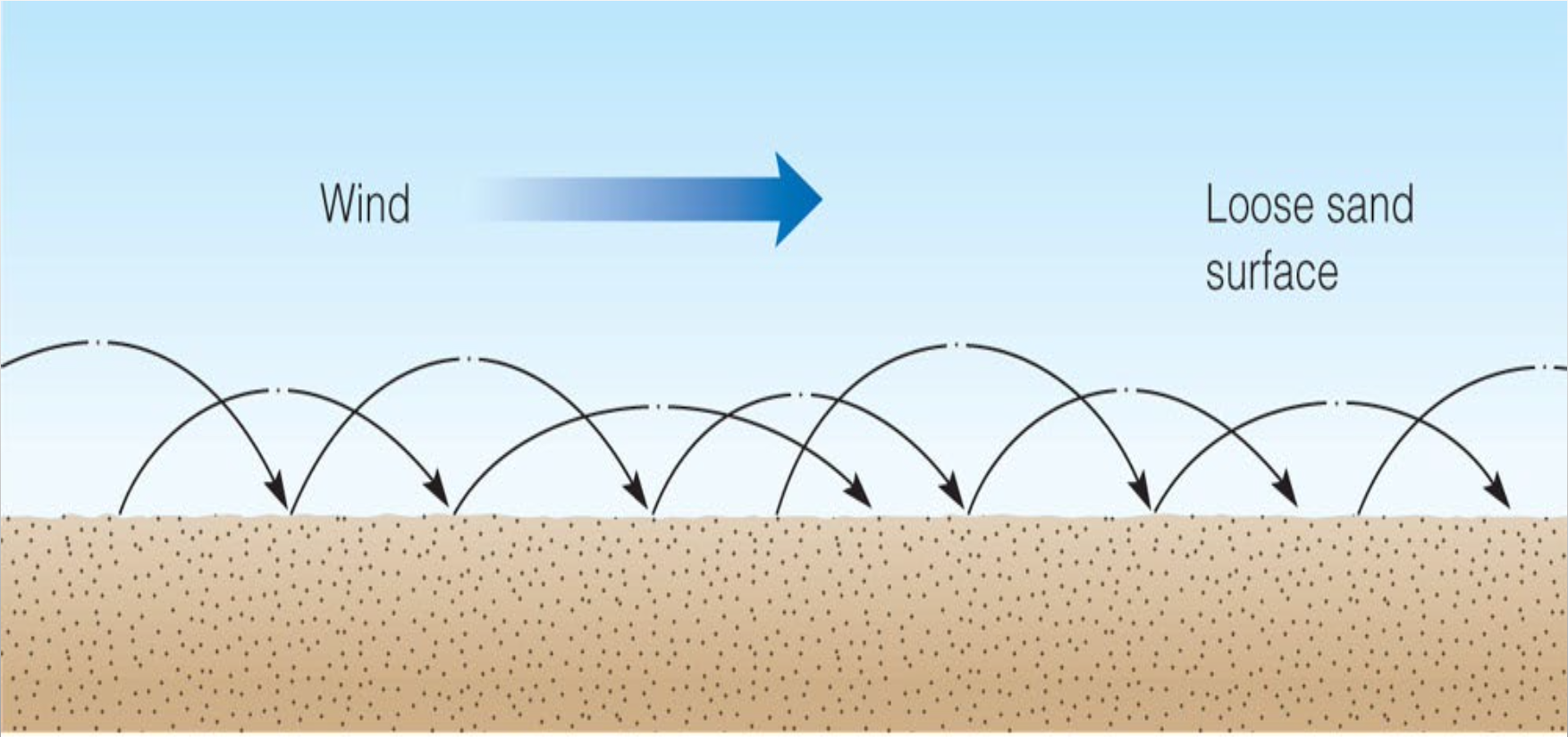
In sand dune migration, describe the movement of the sand grains relative to the wind direction.
The sand grains move up the windward side and slide down the leeward slope.
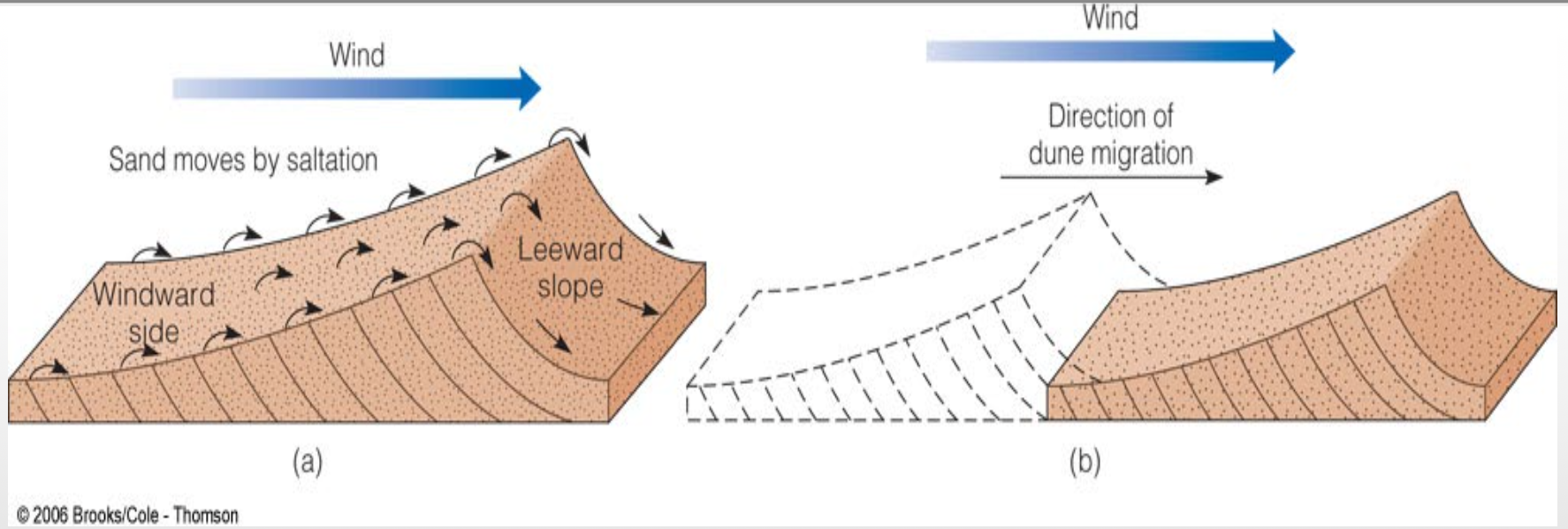
Do cross-beds slope parallel or perpendicular to the direction of wind movement?
Parallel (ie. they slope in the direction of the wind movement)
A long narrow island of sand lying a short distance offshore from the mainland
Barrier Island
Oxbow lakes form from these types of rivers
Meandering rivers
These are depositional features found on the inside bend of a meandering river.
Point bar
The eroded outer edge of a meander in a river.
Cut bank
A type of river system characterized by multiple interconnected, stable channels that are separated by vegetated or sediment-filled islands.
Anastomosing river
What is the difference between braided and anastomosing rivers?
Braided rivers have unstable, shifting channels with high sediment load and occur in steep, high-energy environments.
Anastomosing rivers have stable, deeper channels with lower sediment load, separated by more permanent vegetated islands and flood basins, found in low-energy environments.
In deltaic sedimentary beds, does the grain size coarsen upwards or downwards?
Upwards
A reservoir rock formed by the weathering of underlying granite
Granite wash sandstone
Where does the precipitation of the chemical or biochemical particles that form chemical/biochemical rocks take place?
At the place of deposition
A type of limestone which is directly formed as a solid (does not experience lithification) and is made up of wave- resistant structures composed of the skeletons of corals, mollusks, sponges, and encrusting algae.
Reefal limestone
Where do reefs form?
Reefs actively grow in shallow, warm seawater on the continental shelf, where there is little or no influx of detrital sediment, especially mud.
TorF: Limestones and dolomites contain nearly half of the world’s petroleum reserves
True
Therefore also true: carbonates contain nearly half of the world’s petroleum reserves
What are the most important chemical reservoir rocks?
Limestones and dolomites
Most of the conventional oil in Alberta is found in which type of reservoir rocks?
Carbonate reefs
TorF: Nearly all of the carbonate rocks observed on the continents were deposited in deep marine environments
False
Almost all of the carbonate rocks observed on the continents were deposited on shallow water platforms, where water depth is less than 20m.
Name two mountain range systems composed of significant carbonate rock formations
The Appalachians
The Great Western Cordillera
What is the main acid that dissolves carbonate bed rock?
Carbonic acid
How is carbonic acid formed?
Carbonic acid (H₂CO₃) is formed when carbon dioxide (CO₂) from the atmosphere dissolves in rainwater.
TorF: Carbonic acid dissolves limestone and produces small scale vugs or large scale caves
True
This enhances both the porosity and permeability of the rock
TorF: Vuggy porosity in carbonate reefs is common
True
An extremely fine-grained limestone composed of microfossil shells
Chalk
Example of chalk outcrops: Needles (Isle of Wight, UK)
TorF: Chalks are naturally very porous and permeable
False
Chalks are very porous but impermeable naturally unless fractured.
Name 2 chalk formations that are important hydrocarbon reservoirs
The Austin Chalk (Texas)
The Ekofisk Chalk (North Sea - offshore Norway)
Does dolomitization enhance or reduce porosity? By how much?
Enhances porosity by approx. 13%
Which rock has the chemical formula CaCO₃ ?
Limestone (ie. calcium carbonate)
Which rock has the chemical formula CaMg(CO₃)₂ ?
Dolomite
hint: magnesium = dolomite
When dolomite forms from limestone (dolomitization) which element partially replaces the Ca in calcite?
Magnesium (Mg)
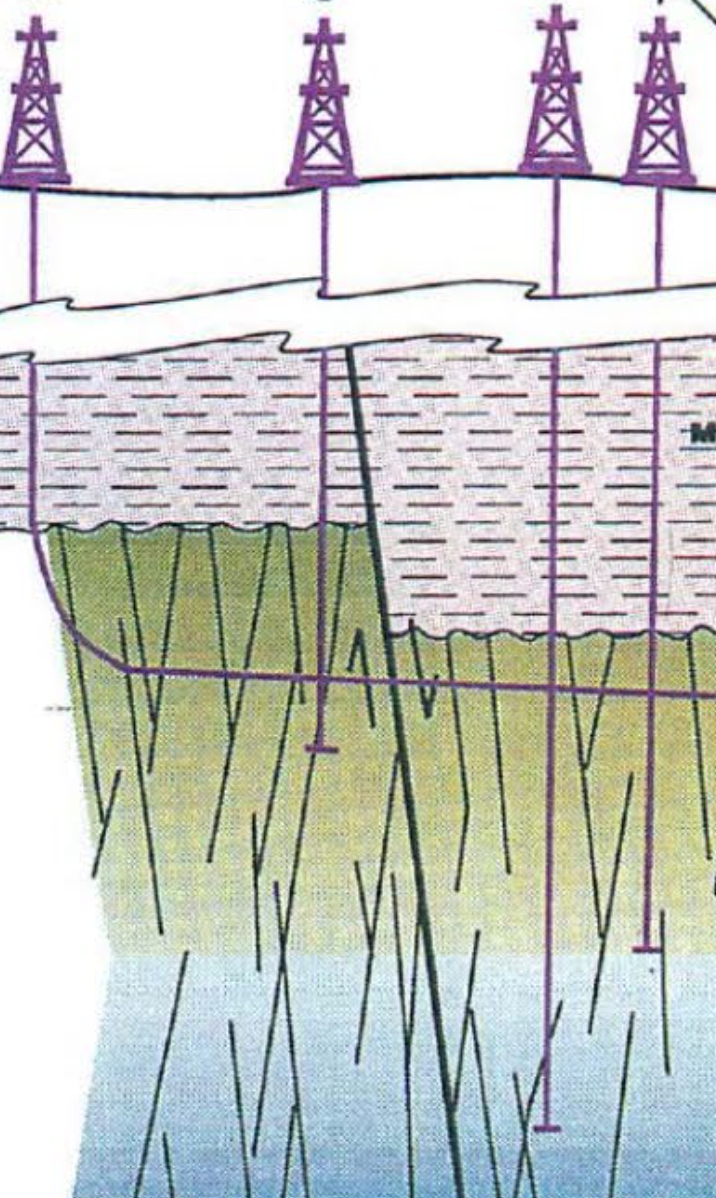
Which of the above 4 wells is a dry hole?
Far right
TorF: Any fractured rock can be a reservoir rock
True
A distinctive landscape formed by the dissolution of soluble rocks, typically limestone, dolomite, or gypsum, through chemical weathering processes involving water
Karst topography
In a Horst and Graben structure, which is the raised feature/which is the sunken?
Horst is raised, Graben is sunken
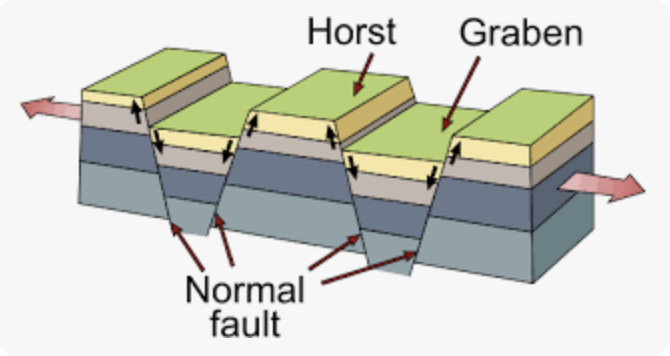
The term for the sediment transportation mechanism that moves larger, heavier particles (like gravel and pebbles) by rolling or sliding them along the riverbed.
Traction
Conglomerate, siltstone and shale are all examples of:
a) Carbonate rocks
b) Siliciclastic rocks
b) Siliciclastic
What is the most common type of siliciclastic rock?
Shale
Do the following geological features/formations represent carbonate or siliciclastic reservoir rocks?
Reefs; Limestone Platforms; Karst Landscape; Chalk; Dolomite; Fractured Reservoirs
Carbonate
Do the following geological features/formations represent carbonate or siliciclastic reservoir rocks?
Dune Sandstones; Shoreline Sandstones; River (Fluvial) Sandstones; Delta Sandstones; “Granite Wash”
Siliciclastic
A hollow steel tube with teeth, commonly diamonds, at the downhole end.
Core barrel (replaces the normal drill bit when coring)
These sub-micron diameter fibers can block pore throats and reduce permeability
Authigenic illite crystals
(negligible porosity reduction + significant permeability reduction)
What is the most accurate method of obtaining information about reservoir characteristics & structures in the reservoir rock?
Coring